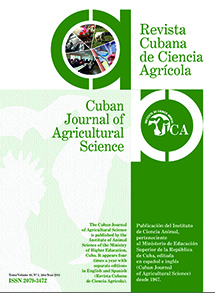Influence of climate on corn (Zea mays) yield in the center of Buenos Aires province, Argentina
Contenido principal del artículo
Resumen
The crop yield is the result of the interactions of the continuum soil-plant-atmosphere in the time. The understanding of these interactions and the description of climate effects on the yield requires a constant effort to reduce the negative effects of the climatic changes. The objective of this study was to determine the influence of agroclimatic variables on the increase of corn (Zea mays) yield for the last decades in Azul municipality, Buenos Aires province, Argentina. The yield series of Ministerio de Agricultura was compared, where a tendency to the increase was observed, with a yield series corrected through a fit equation, to which the technology effect and two yield series simulated in the program Decision Support System for Agrotechnology: "potential yield" and dry "potential yield" for an agricultural soil were take off. These results were linked with agroclimatic variables of maximum and minimum temperature, rainfalls and global radiations. It could verified that when the technology effects disappear, decrease yield (30 %). The increase of potential yield (6.20 %) is associated with the increase of global radiation and temperature. The decrease of rainfalls in the last decade (30 %) cause the fall of the corrected yield series (11 %) and the dry potential yield series (25 %). It is concluded that the climate has a negative effect on yield, but the technology hide it. The decrease of rainfalls in the spring-summer months is the most influence element in the yield.
Key words: crop, agroclimatic variables, technology, Decision Support System for Agrotechnology Transfer.
Detalles del artículo
Aquellos autores/as que tengan publicaciones con esta revista, aceptan los términos siguientes:
- Los autores/as conservarán sus derechos de autor y garantizarán a la revista el derecho de primera publicación de su obra, el cuál estará simultáneamente sujeto a la Licencia Creative Commons Attribution-NonCommercial 4.0 International (CC BY-NC 4.0) que permite a terceros compartir la obra siempre que se indique su autor y su primera publicación esta revista. Bajo esta licencia el autor será libre de:
- Compartir — copiar y redistribuir el material en cualquier medio o formato
- Adaptar — remezclar, transformar y crear a partir del material
- El licenciador no puede revocar estas libertades mientras cumpla con los términos de la licencia
Bajo las siguientes condiciones:
- Reconocimiento — Debe reconocer adecuadamente la autoría, proporcionar un enlace a la licencia e indicar si se han realizado cambios. Puede hacerlo de cualquier manera razonable, pero no de una manera que sugiera que tiene el apoyo del licenciador o lo recibe por el uso que hace.
- NoComercial — No puede utilizar el material para una finalidad comercial.
- No hay restricciones adicionales — No puede aplicar términos legales o medidas tecnológicas que legalmente restrinjan realizar aquello que la licencia permite.
- Los autores/as podrán adoptar otros acuerdos de licencia no exclusiva de distribución de la versión de la obra publicada (p. ej.: depositarla en un archivo telemático institucional o publicarla en un volumen monográfico) siempre que se indique la publicación inicial en esta revista.
- Se permite y recomienda a los autores/as difundir su obra a través de Internet (p. ej.: en archivos telemáticos institucionales o en su página web) antes y durante el proceso de envío, lo cual puede producir intercambios interesantes y aumentar las citas de la obra publicada. (Véase El efecto del acceso abierto).
